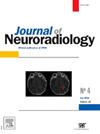Occult craniosynostosis in normocephalic children with Chiari I malformation
IF 3
3区 医学
Q2 CLINICAL NEUROLOGY
引用次数: 0
Abstract
Background
There are numerous theories regarding the development of paediatric Chiari I malformation. We hypothesise a subset may be related to early calvarial suture closure, which may occur too late to cause an abnormal head shape but early enough that changes in intracranial pressure lead to the development of tonsillar descent. Isolated single suture craniosynostosis is not typically associated with Chiari I malformation. We assessed our series of children with Chiari I malformation to establish what proportion harboured an undiagnosed craniosynostosis.
Methods
This was a single-centre retrospective review of all children with Chiari I malformation from 2012 to 2022. Imaging was reviewed for the presence of a craniosynostosis. Clinical records of synostotic patients were reviewed to establish whether they had a craniofacial disorder or were under the care of the craniofacial team. If neither applied then they were considered to have an ‘incidental craniosynostosis’.
Results
The study included six-hundred-and-nineteen patients with Chiari I malformation, with a mean age at diagnosis of 8.7 years. 13.4 % of patients had radiological evidence of an incidentally-detected craniosynostosis, most commonly the sagittal suture (95.7 %). Incidental craniosynostosis was mostly observed in normocephalic children, but dolichocephaly was associated with an increased risk of concurrent sagittal craniosynostosis.
Conclusions
Craniosynostosis in normocephalic children with a Chiari I malformation is an under-diagnosed phenomenon. Given the high rate of correlation we recommend assessing specifically for craniosynostosis in all children with a ‘simple’ Chiari I malformation prior to any intervention.
正常头型患儿隐匿性颅缝闭闭伴Chiari I型畸形。
背景:有许多理论关于发展的儿科奇亚里氏1型畸形。我们假设一个子集可能与早期颅骨缝线闭合有关,这可能发生得太晚而导致头部形状异常,但足够早,颅内压的变化导致扁桃体下降的发展。孤立的单缝合线颅缝闭锁通常与Chiari I型畸形无关。我们评估了我们的Chiari I型畸形患儿系列,以确定未确诊颅缝闭锁的比例。方法:这是一项单中心回顾性研究,研究对象为2012-2022年所有患有Chiari I型畸形的儿童。影像学检查颅缝闭锁的存在。临床记录的结合病人被审查,以确定他们是否有颅面疾病或在颅面小组的护理下。如果两者都不符合,则认为他们患有“偶发性颅缝闭闭”。结果:该研究纳入了619例Chiari I型畸形患者,诊断时平均年龄为8.7岁。13.4%的患者有偶然发现的颅缝闭合的影像学证据,最常见的是矢状缝(95.7%)。偶发性颅缝闭塞多见于正常头型患儿,但头型畸形与并发矢状颅缝闭塞的风险增加有关。结论:正常头型儿童伴Chiari I型畸形的颅缝闭合是一种未被诊断的现象。考虑到高相关性,我们建议在任何干预之前,对所有患有“单纯”Chiari I型畸形的儿童进行颅缝闭锁的专门评估。
本文章由计算机程序翻译,如有差异,请以英文原文为准。
求助全文
约1分钟内获得全文
求助全文
来源期刊

Journal of Neuroradiology
医学-核医学
CiteScore
6.10
自引率
5.70%
发文量
142
审稿时长
6-12 weeks
期刊介绍:
The Journal of Neuroradiology is a peer-reviewed journal, publishing worldwide clinical and basic research in the field of diagnostic and Interventional neuroradiology, translational and molecular neuroimaging, and artificial intelligence in neuroradiology.
The Journal of Neuroradiology considers for publication articles, reviews, technical notes and letters to the editors (correspondence section), provided that the methodology and scientific content are of high quality, and that the results will have substantial clinical impact and/or physiological importance.
 求助内容:
求助内容: 应助结果提醒方式:
应助结果提醒方式:


